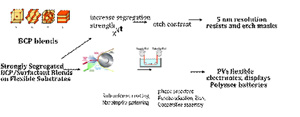NSF Center for Hierarchical Manufacturing, University of Massachusetts Amherst
The rapid generation of highly-ordered arrays of nanoscopic elements with periodicities of <30 nm render the self-assembly of block copolymers (BCPs) ideal scaffolds and templates for nanofabrication. However, several crucial limitations to enable a broad-based adaptation of BCPs in nanomanufacturing must be addressed in order to demonstrate viability of this approach through well-defined product-oriented outcomes. Based on the approach of BCP templating, the focus of this testbed element includes the production of high-volume, cost-sensitive products (e.g., organic electronics, photovoltaics, energy storage, and flexible displays) that require high-rate processing, low materials cost and an ability to functionalize or modify the BCP template.
Impact
The combination of inexpensive surfactant blends with high throughput Roll-to-Roll Nanoimprint Lithography offers the possibility of low cost manufacturing of well-ordered arrays with sub 10-nm features on flexible substrates. (See Figure 1.)

Challenges, Issues, and Methods
- Generating low-cost, commodity scale materials sets
- Demonstrating precision cooperative assembly
- Film stabilization and functionalization
- Utilize surface directed/guided assembly of critical features via imprint stamping
- Demonstrate fabrication of ordered hybrid nanocomposites at high rates
- Transfer the concepts of topographically directed assembly to flexible polymer substrates exploiting NIL methods
- Develop suitable online metrology
Progress
- Demonstrated <5-nm domains using blends of low cost surfactant copolymers with selectively associating homopolymers1.
- <5 nm domains by complexing polystyrene-block-polyethylene oxide block copolymers with metal salts2.
- Demonstrated a simple process that can be used to direct the assembly and long range order of low molecular weight BCPs during solvent annealing to obtain single crystal-like microdomain arrays over macroscopic surfaces (Figure 2)3.
- Utilize “easy Soft-NIL”, allowing for rapid molding of nanoscale features during the subsequent imprint-and-cure stage of the process4 to produce regular topographical constraints (channels and posts) with periods of approximately 100 nm.
- Demonstrated that the addition of nanoparticle mimics containing multiple ligands that can hydrogen bond to the PEO segments of block copolymer surfactants can induce long range order in these systems at high particle loadings.
- Extended flow coating to develop films with linear and non-linear assemblies of both polymers and inorganic nanoparticles in a self-assembled manner.
Industrial Sectors of Interest
Specific industry/market sectors impacted by results of the testbed include flexible electronics, flexible displays, photonics, photovoltaics, data storage, magnetic recording, separations and membranes, lithium polymer batteries, ultracapacitors.
References
- Tirumala, V. R.; Daga, V.; Bosse, A.; Romang, A.; Llavsky, J.; Lin, E.; Watkins, J. J., Well-Ordered Polymer Melts with 5 nm Lamellar Domains from Blends of a Disordered Block Copolymer and a Selectively Associating Homopolymer of Low or High Molar Mass. Macromolecules 2008, 41, (21), 7978-7985.
- Wang, J. Y.; Chen, W.; Roy, C.; Sievert, J. D.; Russell, T. P., Influence of ionic complexes on phase behavior of polystyrene-b-poly(methyl methacrylate) copolymers. Macromolecules 2008, 41, (3), 963-969.
- Macroscopic 10-Terabit–per–Square-Inch Arrays from Block Copolymers with Lateral Order, Soojin Park, Dong Hyun Lee, Ji Xu, Bokyung Kim, Sung Woo Hong, Unyong Jeong, Ting Xu, Thomas P. Russell , Science, vol 323 No. 5917, pp. 1030-1033
- Moran, I. W.; Briseno, A. L.; Loser, S.; Carter, K. R., Device fabrication by easy soft imprint nano-lithography. Chemistry of Materials 2008, 20, (14), 4595-4601.
This work is licensed under a Creative Commons Attribution-NonCommercial-NoDerivs 3.0 Unported.
